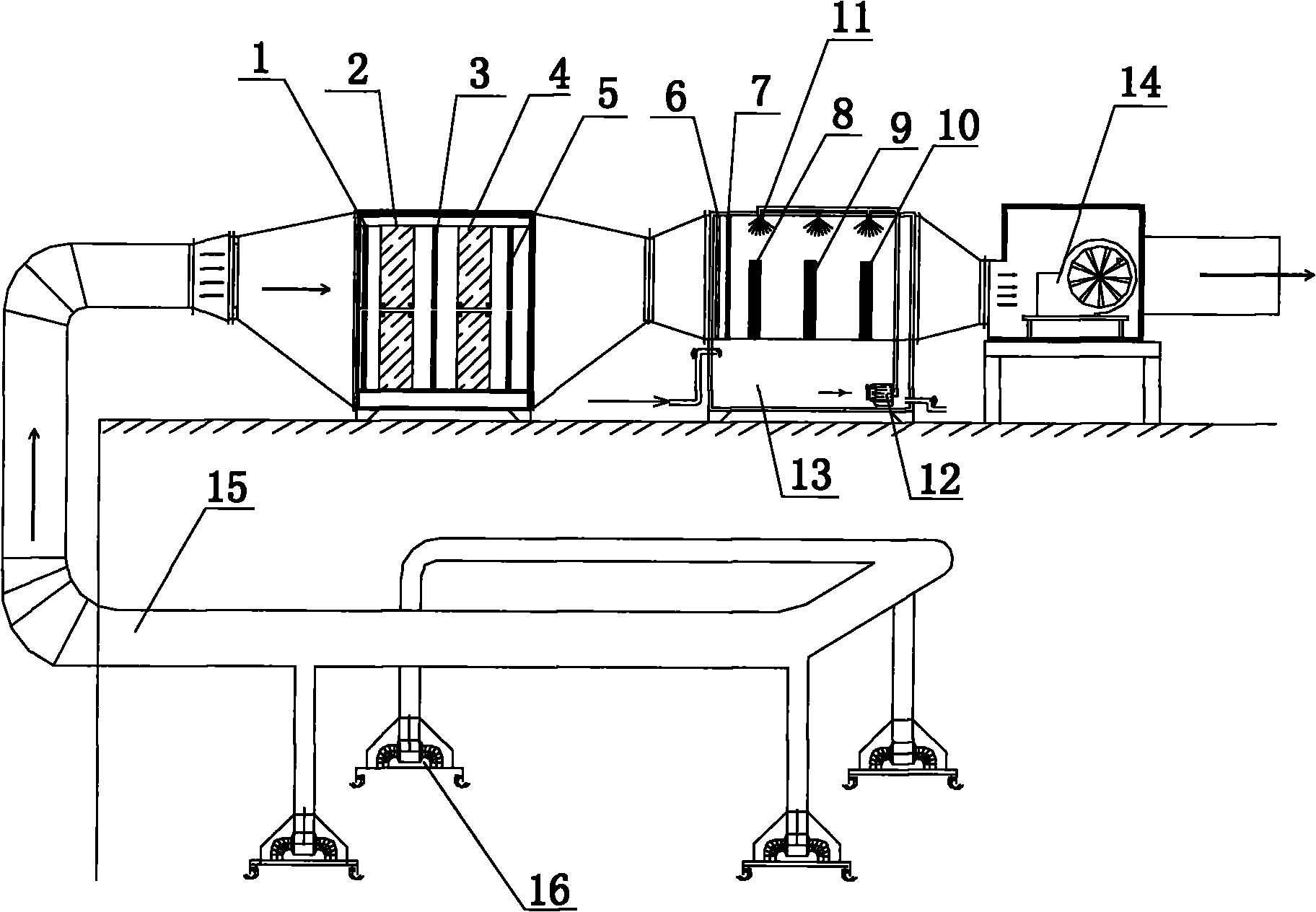Nanometer photocatalytic plasma biological deodorization method and full automatic peculiar smell control deodorization system
A plasma and nano-light technology, applied in the field of odor removal, can solve the problems of secondary pollution, high cost of activated carbon regeneration, inappropriateness, etc., and achieve the effect of high purification rate and simple and effective deodorization
Inactive Publication Date: 2010-08-25
郑承煜
View PDF0 Cites 25 Cited by
- Summary
- Abstract
- Description
- Claims
- Application Information
AI Technical Summary
Problems solved by technology
Second, the current domestic common traditional processing methods
Activated carbon uses porous physical properties to adsorb macromolecular gases and suspended particles in the air. Most of them achieve the purpose of filtering the air through forced air circulation. The filter element needs to be replaced regularly. The actual use efficiency is not high, and it cannot eradicate harmful gases.
In addition, activated carbon can only temporarily absorb a certain amount of odor. When the temperature and wind speed rise to a certain level, the adsorbed odor and odor may be freed and enter the breathing space again. The adsorption is saturated and no longer has adsorption. When the capacity is high, if the filter material is not replaced, the odor, odor, bacteria, etc. it absorbs will be released at any time and become an invisible bomb
The water washing and absorption method has poor effect on hydrogen sulfide and mercaptans; the liquid washing and absorption method has secondary pollution, and wastewater treatment is required, which is not suitable; although the direct combustion method has a good deodorization effect, it requires combustion equipment and high combustion costs; The catalytic combustion method requires precious metals as catalysts and is prone to aging, high cost, and the effect is not ideal; the one-time engineering measures of activated carbon adsorption and ozonation method are relatively simple and the deodorization effect is also ideal, but the management of activated carbon adsorption is time-consuming and laborious. The cost of carbon regeneration is high; in addition to the high cost of the ozone oxidation method, safety measures need to be strengthened
Method used
the structure of the environmentally friendly knitted fabric provided by the present invention; figure 2 Flow chart of the yarn wrapping machine for environmentally friendly knitted fabrics and storage devices; image 3 Is the parameter map of the yarn covering machine
View moreImage
Smart Image Click on the blue labels to locate them in the text.
Smart ImageViewing Examples
Examples
Experimental program
Comparison scheme
Effect test
Embodiment Construction
the structure of the environmentally friendly knitted fabric provided by the present invention; figure 2 Flow chart of the yarn wrapping machine for environmentally friendly knitted fabrics and storage devices; image 3 Is the parameter map of the yarn covering machine
Login to View More PUM
| Property | Measurement | Unit |
|---|---|---|
| height | aaaaa | aaaaa |
Login to View More
Abstract
The invention relates to a nanometer photocatalytic plasma biological deodorization method. The method comprises the following steps of: a, pre-charged dust collection; b, plasma purification; c, plant extract purification, namely atomizing plant extract to form liquid drops with a diameter of less than 1 mu m and performing purification on the liquid drops; and d, nanometer photocatalytic purification. A nanometer photocatalytic plasma biological deodorization method comprises a primary purification room and a secondary purification room, wherein an outlet of the primary purification room is connected with an inlet of the secondary purification room; the primary purification room is provided with coarse filtering equipment, static dust collecting equipment, a photocatalyst, a plasma purification system and a negative ion generator in sequence from the inlet to the outlet; the secondary purification room is provided with a spray atomizer which atomizes the plant extract stored in the system to form the liquid drops with the diameter of less than 1 mu m; and an outlet of the secondary purification room is connected with an exhaust system. The system has the characteristic of good deodorization effect.
Description
A nano-photocatalytic plasma biological deodorization method and a fully automatic odor control deodorization system technical field The invention relates to the technical field of odor removal, in particular to a nano-photocatalytic plasma biological deodorization method and a fully automatic odor control deodorization system. Background technique 1. Analysis of domestic sewage odor and garbage odor 1. The main components of municipal solid waste are: Municipal solid waste is mainly kitchen waste and fruit peels, which account for about two-thirds of the total garbage. Kitchen waste and fruit peels generally exist in the form of protein, fat and polysaccharides (starch, cellulose, etc.). During the process of fermentation, decay, and decomposition under the action of aerobic and anaerobic bacteria, a variety of odorous gas pollutants will gradually be produced. The simplified expression of the reaction process formula is: The main odor components of municipal sol...
Claims
the structure of the environmentally friendly knitted fabric provided by the present invention; figure 2 Flow chart of the yarn wrapping machine for environmentally friendly knitted fabrics and storage devices; image 3 Is the parameter map of the yarn covering machine
Login to View More Application Information
Patent Timeline
 Login to View More
Login to View More Patent Type & Authority Applications(China)
IPC IPC(8): A61L9/22A61L9/013A61L9/14B01D53/86A61L101/56
Inventor 郑承煜
Owner 郑承煜
Features
- R&D
- Intellectual Property
- Life Sciences
- Materials
- Tech Scout
Why Patsnap Eureka
- Unparalleled Data Quality
- Higher Quality Content
- 60% Fewer Hallucinations
Social media
Patsnap Eureka Blog
Learn More Browse by: Latest US Patents, China's latest patents, Technical Efficacy Thesaurus, Application Domain, Technology Topic, Popular Technical Reports.
© 2025 PatSnap. All rights reserved.Legal|Privacy policy|Modern Slavery Act Transparency Statement|Sitemap|About US| Contact US: help@patsnap.com



